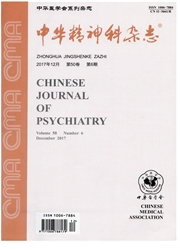

 中文摘要:
中文摘要:
目的建立一种简便、快速检测分析睡眠脑电的新方法,并探讨精神分裂症首次发病(以下简称首发)患者睡眠Quisi特点。方法对50例首发精神分裂症患者(患者组)和44名正常受试者(正常对照组)同步进行Quisi和多导睡眠图(PSG)整夜检测。结果(1)两组分别用Qui8i和PSG二种方法检测12项睡眠指标[即睡眠潜伏期、醒觉时间、醒起时间、睡眠总时间、觉睡比、睡眠效率、睡眠维持率、快眼动睡眠(REM)潜伏期、REM睡眠时间、REM睡眠周期数和第1,2阶段百分比],Quisi与PSG在两组内的差异均无统计学意义(均P〉0.05)。(2)患者组PSG、Quisi两项检测结果与正常对照组比较,经F检验,除REM睡眠周期外,余15项指标(上述Quisi 12项指标加第3,4阶段睡眠百分比、记录中的暂停和伪迹)的差异均有统计学意义(P〈0.05~0.01)。结论Quisi检测精神分裂症作用与PSG相似,为评估精神分裂症患者的睡眠提供了一种客观的检查方法。
 英文摘要:
英文摘要:
Objective To explore the new analysis method, the Quisi, in analyzing sleep EEG, and to explore the characteristic of sleep EEG in first episode schizophrenia patients. Methods Sleep EEG were recorded from 50 patients with first episode schizophrenia and 44 normal subjects, using both Quisi and polysomnography. Results There were no differences in 12 indexes of sleep EEG, i. e. , sleep latency, awake time, early morning awakening time, total sleep time, awake/total sleep time, sleep efficiency, sleep maintenance, REM latency, REM time, number of REM period, percentage of S1 and S2, between Quisi and polysomnography (P 〉 0. 05 ), both in first episode schizophrenia patients and in normal subjects. There were differences on Quisi recorded 15 indexes of sleep EEG ( F test, P 〈 0. 05 - 0. 01 ) between patients and normal subjects. Conclusion Quisi has the similar efficiency to PSG in analyzing sleep EEG, and the sleep architecture in schizophrenia is different from normal subjects.
 同期刊论文项目
同期刊论文项目
 同项目期刊论文
同项目期刊论文
 期刊信息
期刊信息
